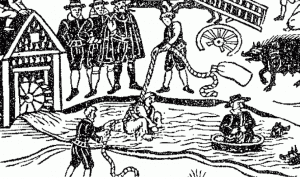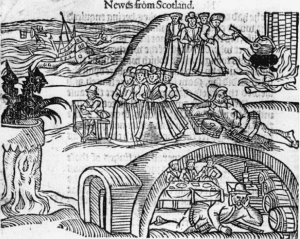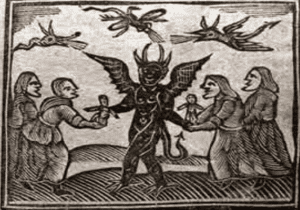From Sabrina to Nicole Kidman in “Bewitched” to the gory american tv series “Salem”, witchcraft is a recurring topic of interest. Nowadays the existence of witches, warlocks, spells and curses has been debunked in modern societies—however, a few centuries ago people believed in these magical creatures, their powers, and feared them.
Let us take a quick dive in history and see what we can discover—what stone may we end up turning. Buckle up, lassie, it’s going to be a bumpy ride!
The rise of witches and witchcraft started off in the 1550s with a few witches here and there. Then came the Witchcraft Act of 1563.
We will be focusing our attention on 16th century Scotland, specifically in the years between 1563-1591. Ready?
Over the course of two decades, there were 2.000 to 6.000 people who were publicly accused of witchcraft—it was almost as if there was a witch in every single house in the Lowlands! The Highlands, in comparison, were considered to be “witch-less”. Scotland had a quarter of England’s population but still the amount of the accused ones was not the double, but the triple of the amount of those in England. Thankfully they were not all executed.
But we are not going to spend time on a single, random witch being burnt alive, or one that was forced to drown so as to prove his/her innocence. That would be too boring.
So how about the story of “James, Geillis and the witch trials”? It may sound like a love story but let me tell you, it is not.

Setting: North Berwick, St. Andrew’s Auld Kirk
Time Period: 1589

It was a cold winter’s day. Suddenly the people of East Lothian started pointing fingers and accusing people of having sex with the devil himself!
It all started on a ship making its way from Scotland, across the sea to reach Denmark. On the ship was King James the sixth, who later came to be King James I of England. The King, being single and all, was in search of a wife…so what did he do?
In 1589 he sailed to Denmark to get himself a wife, but not an ordinary woman. He wanted a princess and, more specifically, Princess Anne, sister of Christian IV, King of Denmark. She had been expected to sail from Denmark but was prevented by storms, three times. James then asked his men to prepare a fleet to fetch Anne. The estimation of the costs involved was high and James decided to raise the funds and make the voyage himself. After their marriage, they returned to Scotland. The trip home however was not as pleasant as they would have hoped.
A great storm hit the ship and they barely made it alive! As a result, they had to find shelter in Norway for several weeks before continuing their trip. The admiral of the escorting Danish fleet blamed the storm on the wife of a high official in Copenhagen whom he had insulted. Several nobles of the Scottish court were implicated, and witchcraft trials were held. The King was certain that this was the work of witches—he did become acquainted with witch-hunting in Denmark.
After all, God would never do something like that now, would he? It must have been SATAN!
In 1590, King James VI was informed that in North Berwick, a fishing port on the east coast of Scotland, was a coven of witches who had been working against the King, trying to cause his death through sorcery. So who did it? The Scots or the Danes?
Well, one of the first Danish victims was Anna Koldings, who, under pressure, revealed the names of five other women. They all confessed that they had been guilty of sorcery in raising storms that menaced Queen Anne’s voyage, and that they had sent demons to climb up the keel of her ship. In September, two women were burnt as witches.
The King—understandably—was not happy with the deaths of only two women. He needed more! But how many more?

The King ordered in 1590 a witch-hunt, the first one to take place after the Witchcraft Act of 1563. His first suspect was none other than G(e)illis Duncan(e).
Geillis…familiar name…where have I heard it before…hhmm oh yes! The red-haired time traveller from Mrs. Gabaldon’s Outlander!
Turns out there was a living woman with that name! How about that!
She worked for a man named David Seaton in the town of Tranent and he made her confess her involvement in bewitching King James’s ship. Turns out that she was acting suspiciously.
She began to exhibit a miraculous healing ability and would sneak out of the house during the night. Could she be meeting a secret lover? Nah, probably doing black magic sh*t. When confronted, she could not explain her new ability and strange behaviour so, her boss had her tortured. Under pressure, she confessed of being a witch and accused many others of witchcraft. She named over 70 people, accusing them of practising witchcraft themselves. The accused, accused even more people. In the end, while in captivity, more than 100 people were connected to the case. They admitted to their involvement only after being tormented. The majority of 70 suspects rounded up in North Berwick and confessed to plotting under the Devil’s orders against the King. The trials ran for two years.
The “witches” held their covens on the Auld Kirk Green, part of the modern-day North Berwick Harbour area. Their admitting to being the Devil’s pawn were almost all of them extracted via torture, which took place in Edinburgh. WOW.
His actions may have been driven by childhood trauma. His mother Mar,. Queen of Scots, was eventually executed by Elizabeth I in 1587. So young James could have associated the traumatic event with dark, satanic spirits, believing that it had been foretold by witches who had seen “a bloody head dancing in the air.” Mommy issues…go figure…
James commissioned “Newes from Scotland”, a pamphlet that relayed the whole saga in scandalized language aiming at intensifying a popular fear of witches. But he did not stop there.
In 1597 he became the only monarch in history to publish a treatise on witchcraft. His goal was to proclaim a “godly state”, to lessen the power of women, to make them appear as weak and gullible, easy to trick and of course, to prevent them from having an opinion on socio-political subjects. It is no secret that the witch hunts, although they did not benefit anyone financially, they often began when poverty started increasing or when people started getting really hungry.
James enlarged his people’s fears with his own book Daemonologie, in which he deployed his formidable powers to catalog the spells and sorcery of witches, and the art of communicating with the dead.
James imported continental explanations of witchcraft. He thought that women threatened his political power so he laid the foundation for witchcraft and occultism policies, especially in Scotland. When he became King James I of England and applied the Witchcraft Act of 1604, the response was not one he had expected. Englanders were more skeptical than Scotsmen, which made him evaluate his stances.
You’ve ever seen or heard of Macbeth? No?
Well too bad. It has been noted that the themes taken from Daemonologie and King James’ involvement in the North Berwick witch trials may have directly contributed to Shakespeare‘s work “Macbeth”. Evidence of this exists in the three witches use of ritual magic and direct quotes that directly relate to the testimony given from the witch trials described in the Newes of Scotland pamphlet. “Macbeth” came into the world a few years after the publication of Daemonologie and retains many of the same Scottish themes and settings. Borrowing many quotes from the treaties, the three witches cast their spells in the same manner: “purposely to be cassin into the sea to raise winds for the destruction of ships.” King James’s madness will live through Shakespeare’s work.

This was just one of many series of bloody witch hunts in Scotland, where people were put to the flames in some of the grisly mass slaughters of their day.
Well, what did you think of my article?
I would love to read about your thoughts…and who knows, maybe you will see your ideas featured in one of my next books!
Written by Lydia Kendall

 Share this book
Share this book